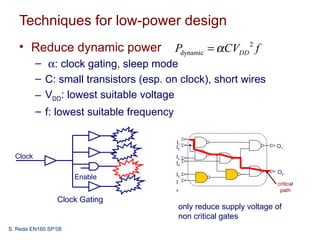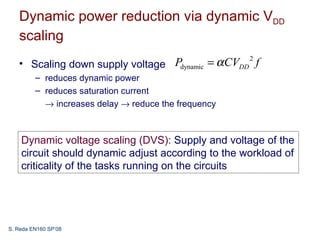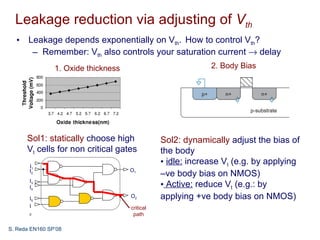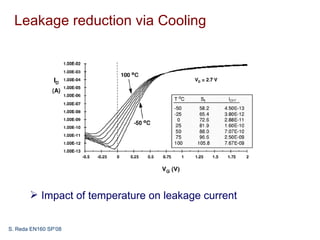Lecture14
- 1. Design and Implementation of VLSI Systems (EN1600) Lecture 14: Power Dissipation S. Reda EN160 SP’08
- 2. Power and Energy • Power is drawn from a voltage source attached to the VDD pin(s) of a chip. • Instantaneous Power: P(t ) = iDD (t )VDD T T • Energy: E = ∫ P(t )dt = ∫ iDD (t )VDD dt 0 0 T E 1 • Average Power: Pavg = = ∫ iDD (t )VDD dt T T 0 S. Reda EN160 SP’08
- 3. Dynamic power • Dynamic power is required to charge and discharge load capacitances when transistors switch. • One cycle involves a rising and falling output. • On rising output, charge Q = CVDD is required • On falling output, charge is dumped to GND VDD • This repeats Tfsw times iDD(t) over an interval of T C fsw S. Reda EN160 SP’08
- 4. Dynamic power dissipation Vdd Vin Vout load capacitance CL (gate + diffusion + interconnects) Energy delivered by the supply during input 1 → 0 transition: Energy stored at the capacitor at the end of 1 → 0 transition: dissipated in NMOS during discharge S. Reda EN160 SP’08 (input: 0 → 1)
- 5. Capacitive dynamic power If the gate is switched on and off f0→1 (switching factor) times per second, the power consumption is given by For entire circuit where αi is activity factor [0..0.5] in comparison to the clock frequency (which has switching factor of 1) Pdynamic = α CVDD 2 f S. Reda EN160 SP’08
- 6. Short circuit current • When transistors switch, both nMOS and pMOS networks may be momentarily ON at once • Leads to a blip of “short circuit” current. • < 10% of dynamic power if rise/fall times are comparable for input and output S. Reda EN160 SP’08
- 7. Dynamic power breakup Gate 34% Interconnect 51% Diffusion 15% Total dynamic Power [source: Intel’03] S. Reda EN160 SP’08
- 8. Static (leakage) power • Static power is consumed even when chip is quiescent. – Leakage draws power from nominally OFF devices Vgs −Vt −Vds I ds = I ds 0e nvT 1 − e vT S. Reda EN160 SP’08
- 9. Techniques for low-power design • Reduce dynamic power Pdynamic = α CVDD 2 f – α: clock gating, sleep mode – C: small transistors (esp. on clock), short wires – VDD: lowest suitable voltage – f: lowest suitable frequency I1 I2 O1 Clock I3 I4 I5 O2 Enable I critical 6 path Clock Gating only reduce supply voltage of non critical gates S. Reda EN160 SP’08
- 10. Dynamic power reduction via dynamic VDD scaling • Scaling down supply voltage Pdynamic = α CVDD f 2 – reduces dynamic power – reduces saturation current → increases delay → reduce the frequency Dynamic voltage scaling (DVS): Supply and voltage of the circuit should dynamic adjust according to the workload of criticality of the tasks running on the circuits S. Reda EN160 SP’08
- 11. Leakage reduction via adjusting of Vth • Leakage depends exponentially on Vth. How to control Vth? – Remember: Vth also controls your saturation current → delay 1. Oxide thickness 2. Body Bias Sol1: statically choose high Sol2: dynamically adjust the bias of Vt cells for non critical gates the body I1 • idle: increase Vt (e.g. by applying I2 O1 –ve body bias on NMOS) I3 I4 • Active: reduce Vt (e.g.: by I5 O2 applying +ve body bias on NMOS) I critical 6 path S. Reda EN160 SP’08
- 12. Leakage reduction via Cooling Impact of temperature on leakage current S. Reda EN160 SP’08
- 13. Summary We are still in chapter 4: Delay estimation Power estimation Interconnects and wire engineering Scaling theory S. Reda EN160 SP’08





![Capacitive dynamic power
If the gate is switched on and off f0→1 (switching factor) times
per second, the power consumption is given by
For entire circuit
where αi is activity factor [0..0.5] in comparison to the clock
frequency (which has switching factor of 1)
Pdynamic = α CVDD 2 f
S. Reda EN160 SP’08](https://image.slidesharecdn.com/lecture14-120612013848-phpapp02/85/Lecture14-5-320.jpg)

![Dynamic power breakup
Gate
34%
Interconnect
51%
Diffusion
15%
Total dynamic Power
[source: Intel’03]
S. Reda EN160 SP’08](https://image.slidesharecdn.com/lecture14-120612013848-phpapp02/85/Lecture14-7-320.jpg)





